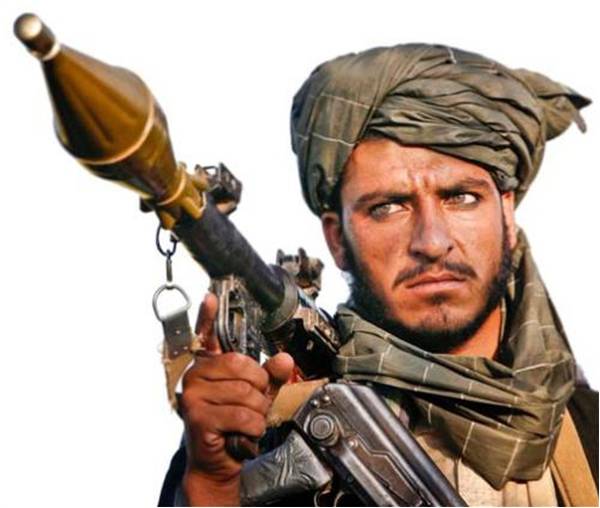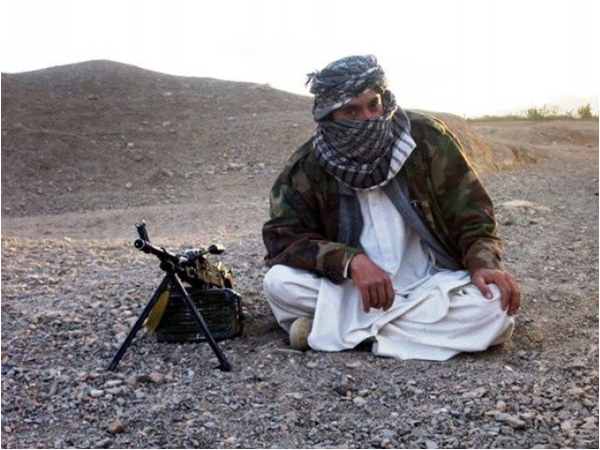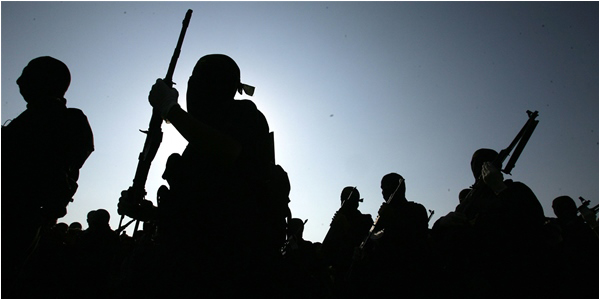
Although it is far from becoming a significant force in the Afghanistan-Pakistan region, the Islamic State (IS) has started to worry the Afghan Taliban, Al Qaeda, and groups affiliated with them, insiders and analysts say.
On July 6, Hizb-e-Islami chief Gulbuddin Hekmatyar asked his militants to support the Islamic State in its fight against Taliban – his old rivals who formed a government in Kabul by throwing out the Afghan Mujahedeen, including himself. That is the latest in a series of bad news for Afghan Taliban and Al Qaeda.
Hizb-e-Islami, which has claimed several terrorist acts in Afghanistan, including an attack on a team of aid workers in the Badakhshan province in 2010 and a bomb explosion targeting a pair of US military vehicles in 2013 – was in contact with IS for long, sources in Peshawar say. The distribution of IS leaflets in Afghan refugee camps in Peshawar last year was believed to be the handiwork of Hizb-e-Islami, although the group’s leaders had rejected the allegation.
The organization led by the former Afghan prime minister has thousands of active fighters in Afghanistan and it is likely to help IS recruit and establish a base in the region, say analysts closely watching the activities of one of the oldest Jihadi group of the region.
Background interviews with locals suggest that a ‘threatening letter’ from Afghan Taliban – who want to be named the Islamic Emirate of Afghanistan – was also a sign of fears about the IS that persist among the Taliban ranks. Zubair Babakarkhail, a Kabul based journalist, agrees that the letter demonstrates the very high degree of concern.
“Taliban have declared 2015 the year of their ultimate victory, and they are now faced with a new problem in shape of the IS, which is threatening to make their decade-long efforts futile,”says Babakarkhail, who has been interacting with local Taliban commanders for his journalistic assignments.

“Initially, the Afghan Taliban’s policy was to ignore the IS and not give them too much importance,” says Hasan Abdullah, an Islamabad based security analyst. But later, they felt that the IS was trying to create friction, polarize the jihadis, and instigate a rebellion against the leadership of Mullah Umar.”
The letter, addressed to IS leader Abu Bakr al-Baghdadi from Al-Haj Mullah Akhtar Mansoor – the deputy of Mullah Umar – was written on June 16, and has underscored the importance of unity among jihadis, which according to the Taliban leadership could be maintained only if both the groups continued to work in their own areas of influence – Afghanistan, and the Arab world.
“It seems that through the letter, the Taliban have tried to gain a high moral ground while trying to contain IS at the same time,” says Abdullah.
To many, the letter is more than a threat from the Taliban to the Iraq and Syria based terrorist outfit. They say it was aimed at making it clear that Taliban don’t subscribe to the IS viewpoint. They openly oppose its presence in the region, deeming it against the Jihadi cause.
Babrak Yousafzai, a journalist from the Nangarhar province of Afghanistan, however gives little importance to the letter. He says it made very little impact on the IS, which issued on its website a retaliatory ‘warning’ to Taliban commanders to either join their Khorasan (Afghanistan) chapter, or get ready to be killed.
Babakarkhail sees IS a ‘not-so-distant’ threat to both the Afghan government and the Taliban.
According to a report published on June 30, fighting between Taliban and IS has spread across several districts in the Nangarhar province. In January, Maulana Abdul Rauf, an important Afghan Taliban commander from Helmond province, paid allegiance to Al Baghdadi.
The announcement was followed by severe fighting. By now, the IS has gained Helmond, Farah and Nangarhar, three of the Afghanistan’s 34 provinces.

On July 5, the militants of IS warned local farmers in the eastern Nangarhar province to stop cultivating opium. They also reportedly slapped some local smokers and those using ‘naswar’, a famous tobacco snuff consumed by Pashtuns around the world.
On January 27, on Pakistani side of the Durand Line, an important Pakistani Taliban leader, Hafiz Saeed Khan, announced his allegiance to Al Baghdadi and reportedly took charge as the emir of IS in Pakistan and Afghanistan. Some disgruntled Taliban groups like Tehreek-e-Taliban Pakistan’s Mehmond chapter, and the former TTP spokesman Shahidullah Shahid, also announced allegiance to the IS chief – a new claimant for the title Ameerul Momineen, which was previously claimed by Mullah Umar.
Before that, IS literature was distributed in the Afghan refugees camps of Shamshato and Jalozai in September last year. The leaflets, though published in the Mohallah Jangi area of the city, could not be distributed in the settled areas. Since one of the camps is considered the headquarters of Hekmatyar’s Hizb-e-Islami, it was believed that the IS might be enjoying the support of the group.
Among the prominent activities of IS was “wall chalking” in the Baloch belt of Balochistan province — an area with little or no Taliban and Al Qaeda influence. Two recent police statements indicate IS’ growing influence over the militants already associated with Al Qaeda.
Experts sy if the IS intends to launch itself in the region, then, like other militant organizations, would have to build a proper organizational structure, which they lack at present.
Al Qaeda too has announced a South Asia chapter, which analysts see as a reaction to IS activities in Pakistan. The IS is trying hard, and the support from the Hizb will help it organize itself in the region, one expert said.
But does is it in a position to become a real threat to the much larger Taliban and their allies?
“So far it seems that the IS does not have a very strong footprint in the region,” says Abdullah. “On the other hand, the Afghan Taliban are well organised and there is a strong alliance between them and Al Qaeda.” The IS has tried to assert its authority in parts of Afghanistan but so far it seems to be lacking the grassroots support enjoyed by Taliban and Al Qaeda, he says.
That is not their only problem. The IS might fail to have a strong foothold in Afghanistan, analysts say, because the its instructions to locals to stop cultivating opium – which serves as a key source of income for Afghans – will further hurt the support they have among the locals, if any.
In background interviews, many locals see the IS as a foreign group. According to Babrak, many in Afghanistan also believe that the IS enjoys the support of the US and some European countries.
The IS has turned out to be harsher with the people of the Shia community than the Taliban, forcing the Shia Hazaras in the southern districts to form an anti-IS alliance with Taliban.
The Afghans – most dominantly Hanafi Muslims – are also opposing the IS on the ground of their typical Wahabi ideology.
Unlike Afghanistan, recent disclosures reveal that the young people in Pakistan are attracted towards the IS. On July 1, a Karachi police official, Raja Umar Khattab, claimed that the suspects in the recent attack on Ismaili Shias and liberal activist Sabeen Mahmud – said to be associated with Al Qaeda in South Asia – were also inspired by the IS.
A day later, three suspects were arrested in Peshawar. Two of them, Asmatullah and Abdur Rehman, are Afghan nationals also inspired by the Islamic State.
The IS’ gains in Afghanistan and its influence over the young minds in Pakistan may not be an immediate threat to the militants already active in the region, but possible infighting between the rival groups fighters will certainly be a threat to peace in the region.
The writer is a freelance journalist
Email: undisclosedtruth@gmail.com
Twitter: @NKMalazai
On July 6, Hizb-e-Islami chief Gulbuddin Hekmatyar asked his militants to support the Islamic State in its fight against Taliban – his old rivals who formed a government in Kabul by throwing out the Afghan Mujahedeen, including himself. That is the latest in a series of bad news for Afghan Taliban and Al Qaeda.
Hizb-e-Islami, which has claimed several terrorist acts in Afghanistan, including an attack on a team of aid workers in the Badakhshan province in 2010 and a bomb explosion targeting a pair of US military vehicles in 2013 – was in contact with IS for long, sources in Peshawar say. The distribution of IS leaflets in Afghan refugee camps in Peshawar last year was believed to be the handiwork of Hizb-e-Islami, although the group’s leaders had rejected the allegation.
Many Afghans see the IS as foreigners
The organization led by the former Afghan prime minister has thousands of active fighters in Afghanistan and it is likely to help IS recruit and establish a base in the region, say analysts closely watching the activities of one of the oldest Jihadi group of the region.
Background interviews with locals suggest that a ‘threatening letter’ from Afghan Taliban – who want to be named the Islamic Emirate of Afghanistan – was also a sign of fears about the IS that persist among the Taliban ranks. Zubair Babakarkhail, a Kabul based journalist, agrees that the letter demonstrates the very high degree of concern.
“Taliban have declared 2015 the year of their ultimate victory, and they are now faced with a new problem in shape of the IS, which is threatening to make their decade-long efforts futile,”says Babakarkhail, who has been interacting with local Taliban commanders for his journalistic assignments.

“Initially, the Afghan Taliban’s policy was to ignore the IS and not give them too much importance,” says Hasan Abdullah, an Islamabad based security analyst. But later, they felt that the IS was trying to create friction, polarize the jihadis, and instigate a rebellion against the leadership of Mullah Umar.”
The letter, addressed to IS leader Abu Bakr al-Baghdadi from Al-Haj Mullah Akhtar Mansoor – the deputy of Mullah Umar – was written on June 16, and has underscored the importance of unity among jihadis, which according to the Taliban leadership could be maintained only if both the groups continued to work in their own areas of influence – Afghanistan, and the Arab world.
“It seems that through the letter, the Taliban have tried to gain a high moral ground while trying to contain IS at the same time,” says Abdullah.
The IS has warned the Taliban commanders to join them or get ready to be killed
To many, the letter is more than a threat from the Taliban to the Iraq and Syria based terrorist outfit. They say it was aimed at making it clear that Taliban don’t subscribe to the IS viewpoint. They openly oppose its presence in the region, deeming it against the Jihadi cause.
Babrak Yousafzai, a journalist from the Nangarhar province of Afghanistan, however gives little importance to the letter. He says it made very little impact on the IS, which issued on its website a retaliatory ‘warning’ to Taliban commanders to either join their Khorasan (Afghanistan) chapter, or get ready to be killed.
Babakarkhail sees IS a ‘not-so-distant’ threat to both the Afghan government and the Taliban.
According to a report published on June 30, fighting between Taliban and IS has spread across several districts in the Nangarhar province. In January, Maulana Abdul Rauf, an important Afghan Taliban commander from Helmond province, paid allegiance to Al Baghdadi.
The announcement was followed by severe fighting. By now, the IS has gained Helmond, Farah and Nangarhar, three of the Afghanistan’s 34 provinces.

On July 5, the militants of IS warned local farmers in the eastern Nangarhar province to stop cultivating opium. They also reportedly slapped some local smokers and those using ‘naswar’, a famous tobacco snuff consumed by Pashtuns around the world.
On January 27, on Pakistani side of the Durand Line, an important Pakistani Taliban leader, Hafiz Saeed Khan, announced his allegiance to Al Baghdadi and reportedly took charge as the emir of IS in Pakistan and Afghanistan. Some disgruntled Taliban groups like Tehreek-e-Taliban Pakistan’s Mehmond chapter, and the former TTP spokesman Shahidullah Shahid, also announced allegiance to the IS chief – a new claimant for the title Ameerul Momineen, which was previously claimed by Mullah Umar.
Before that, IS literature was distributed in the Afghan refugees camps of Shamshato and Jalozai in September last year. The leaflets, though published in the Mohallah Jangi area of the city, could not be distributed in the settled areas. Since one of the camps is considered the headquarters of Hekmatyar’s Hizb-e-Islami, it was believed that the IS might be enjoying the support of the group.
Among the prominent activities of IS was “wall chalking” in the Baloch belt of Balochistan province — an area with little or no Taliban and Al Qaeda influence. Two recent police statements indicate IS’ growing influence over the militants already associated with Al Qaeda.
Experts sy if the IS intends to launch itself in the region, then, like other militant organizations, would have to build a proper organizational structure, which they lack at present.
Al Qaeda too has announced a South Asia chapter, which analysts see as a reaction to IS activities in Pakistan. The IS is trying hard, and the support from the Hizb will help it organize itself in the region, one expert said.
But does is it in a position to become a real threat to the much larger Taliban and their allies?
“So far it seems that the IS does not have a very strong footprint in the region,” says Abdullah. “On the other hand, the Afghan Taliban are well organised and there is a strong alliance between them and Al Qaeda.” The IS has tried to assert its authority in parts of Afghanistan but so far it seems to be lacking the grassroots support enjoyed by Taliban and Al Qaeda, he says.
That is not their only problem. The IS might fail to have a strong foothold in Afghanistan, analysts say, because the its instructions to locals to stop cultivating opium – which serves as a key source of income for Afghans – will further hurt the support they have among the locals, if any.
In background interviews, many locals see the IS as a foreign group. According to Babrak, many in Afghanistan also believe that the IS enjoys the support of the US and some European countries.
The IS has turned out to be harsher with the people of the Shia community than the Taliban, forcing the Shia Hazaras in the southern districts to form an anti-IS alliance with Taliban.
The Afghans – most dominantly Hanafi Muslims – are also opposing the IS on the ground of their typical Wahabi ideology.
Unlike Afghanistan, recent disclosures reveal that the young people in Pakistan are attracted towards the IS. On July 1, a Karachi police official, Raja Umar Khattab, claimed that the suspects in the recent attack on Ismaili Shias and liberal activist Sabeen Mahmud – said to be associated with Al Qaeda in South Asia – were also inspired by the IS.
A day later, three suspects were arrested in Peshawar. Two of them, Asmatullah and Abdur Rehman, are Afghan nationals also inspired by the Islamic State.
The IS’ gains in Afghanistan and its influence over the young minds in Pakistan may not be an immediate threat to the militants already active in the region, but possible infighting between the rival groups fighters will certainly be a threat to peace in the region.
The writer is a freelance journalist
Email: undisclosedtruth@gmail.com
Twitter: @NKMalazai

